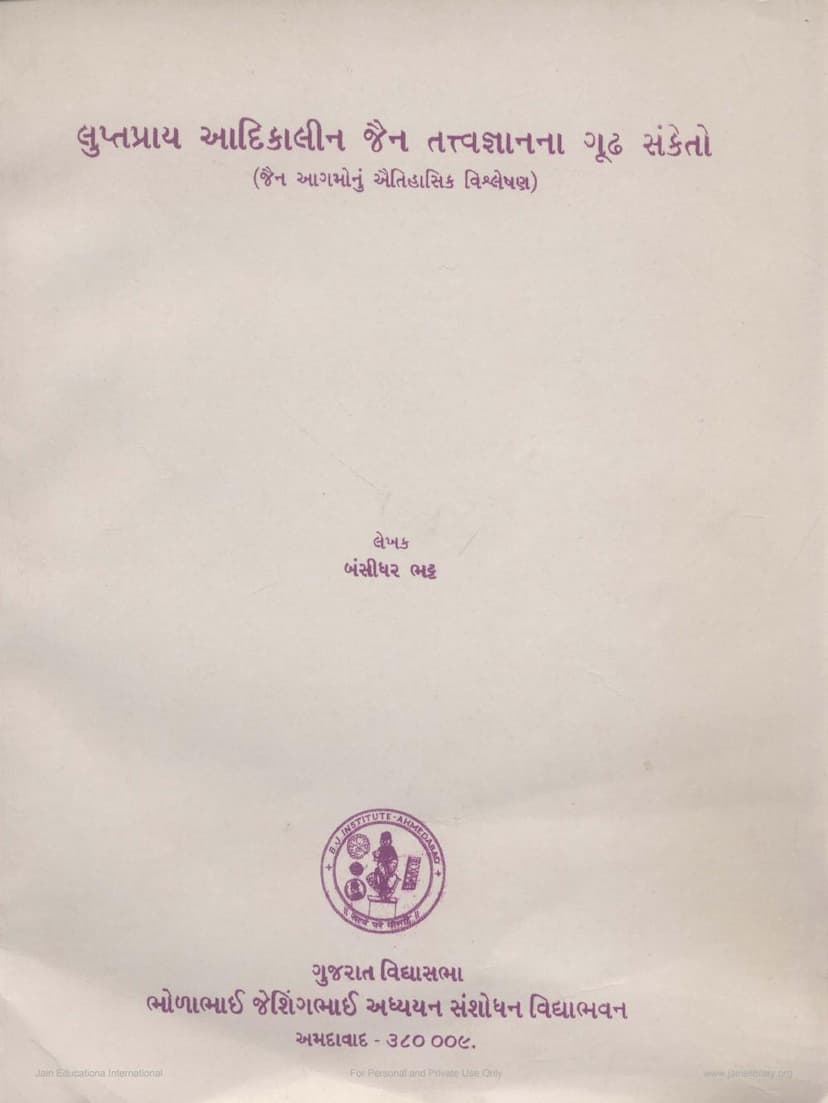Luptapray Aadikalin Jain Tattvagyanna Gudh Sanketo
Added to library: September 2, 2025

Summary
The book "Luptapray Aadikalin Jain Tattvagyanna Gudh Sanketo" (Hidden Symbols of Lost Early Jain Philosophy) by Bansidhar Bhatt, published by B. J. Institute, offers a scholarly analysis of early Jain scriptures, particularly focusing on the Acharya Sutra (Acharanga Sutra). The author, Professor Bansidhar Bhatt from the University of Westphalia, Germany, presents a detailed examination of the first Shruta Skandha (canon section) of the Acharya Sutra, known as Brahmacharya.
The book delves into the historical analysis of Jain Agamas, aiming to shed light on the obscure philosophical concepts of early Jainism. Bhatt's work highlights the intricate and often complex structure of the Jain Agamas, making the task of proving the antiquity of various sections and themes a challenging one.
Key Themes and Arguments:
- Early Jain Philosophy and its Relationship with Vedic Thought: Bhatt meticulously traces the evolution of Jain philosophical ideas and their connections with Vedic and Upanishadic traditions. He argues that while there are similarities, early Jain thought presents unique perspectives.
- Analysis of Acharya Sutra's Brahmacharya: The core of the book lies in its detailed analysis of the Brahmacharya section of the Acharya Sutra. Bhatt examines its various Uddeshas (sub-sections), focusing on the philosophical terminology and concepts used.
- The Concept of Prana vs. Jiva: Bhatt observes the prominent use of the term prana (life force) in Shastra Parijnana (the first Uddesha) to denote life, often implying "soul" or "life principle." He notes that the word jiva (soul/life) is used less frequently and sometimes appears to be a later interpolation. This usage of prana in a vitalistic sense is compared to its similar usage in Upanishadic texts.
- The Six Jiva Nikayas (Categories of Life): The book critically examines the concept of the six categories of life (earth-bodied, water-bodied, fire-bodied, plant-bodied, mobile-bodied, and air-bodied) and how their violation (himsa or violence) is described. Bhatt argues that the Agamas do not posit these elements as kāyas (bodies of life) in the later developed sense, but rather focus on the life forms inhabiting them.
- The Terminology and Philosophical Underpinnings: Bhatt draws parallels between the philosophical terminology in early Jain texts and those found in ancient Upanishads and Brahmanical literature. He highlights words like sparsha (touch), vedana (sensation), moksha (liberation), and samsara (cycle of birth and death), suggesting a shared intellectual heritage.
- The Concept of Brahman and Moksha: The book explores the Jain understanding of liberation (moksha) and its connection to the pursuit of Brahman (the ultimate reality), drawing comparisons with Vedic concepts of ultimate reality and liberation. The author notes the similarities in the ultimate goals of self-realization and freedom from the cycle of existence, while also highlighting the distinct paths and terminologies.
- The "Hidden Symbols" and Lost Philosophy: Bhatt contends that many of the subtle philosophical nuances and early conceptualizations within the Agamas remain "hidden" or "lost" due to later textual developments, interpolations, and sectarian interpretations. His research aims to uncover these original meanings.
- Historical Development of Jain Thought: The book traces the evolution of Jain thought, distinguishing between earlier and later strata of the Agamas. Bhatt suggests that certain chapters of the Acharya Sutra might be older than others, and that concepts like the five great vows (mahavratas) and the twenty-five bhavanas (mental disciplines) developed over time.
- Influence of Brahmanical and Vedic Traditions: Bhatt's work extensively demonstrates the influence of Brahmanical and Vedic traditions on early Jainism. He points out the presence of shared terminology, concepts, and even narrative structures, suggesting a common cultural and intellectual milieu. He argues that Jainism, while distinct, emerged within this broader Indian philosophical landscape.
- The Role of Mahavira and the "New" Presentation of Ideas: While acknowledging Mahavira as a significant figure, Bhatt suggests that the earliest strata of the Acharya Sutra reflect broad philosophical currents rather than being solely attributable to Mahavira's specific teachings. He notes that later texts tend to attribute more of the developed philosophical ideas to him.
- Scholarly Methodology and Critiques: Bhatt engages with the work of prominent scholars like Jacobi, Oldenberg, Schrader, Alsdorf, and P.C. Nahata, often offering critical assessments of their findings and methodologies. He points out perceived limitations and oversights in previous research, advocating for a closer and more nuanced reading of the ancient texts.
In essence, "Luptapray Aadikalin Jain Tattvagyanna Gudh Sanketo" is a dense and scholarly work that attempts to reconstruct the foundational philosophical ideas of early Jainism by meticulously analyzing its scriptural sources. It emphasizes the interconnectedness of early Indian philosophical traditions, while asserting the unique developmental trajectory of Jain thought. The book is aimed at serious scholars and students of Jainism and Indian philosophy.